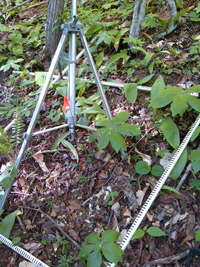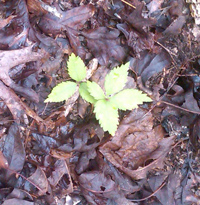 Shiitake mushroom cultivation on hardwood logs.
Shiitake mushroom cultivation on hardwood logs.- What is Forest Farming?
- Suggested herbs, depending on site conditions (shade, soil etc.)
- Resources for selecting plants and cultivation techniques
Forest settings can provide an ideal location for cultivating many valued plants that prefer shaded conditions. Several non-timber forest products, including mushrooms and edible and shade-tolerant plants, can be intentionally cultivated or promoted to reproduce in forests using specific management practices. When considering alternatives for forested land, various elements need to be considered to identify how feasible forest farming will be given the available resources, site characteristics and plans for the land. Ideal forest crops have a relatively high value and are capable of producing profitable volume over the preferred time frame. Georgia and Southeastern growers can improve their income by being part of the ever-increasing supplements and wild crops markets.
What is Forest Farming?
 Cultivated oyster mushrooms.
Cultivated oyster mushrooms.Forest farming can be defined as cultivation of plants under a forest canopy (as opposed to wildcrafting, the practice of collecting wild plants and products from a forest). Forest farmers can manage different layers in the forest structure to increase sustainable harvests of non-timber forest products from natural forests or tree plantations. The canopy trees provide timber, nuts and fruits like pecans or persimmons; the middle layer may be full of mayhaw, vines, berries or ornamentals; and the forest floor can be cultivated for medicinal and culinary herbs, roots, mushrooms and landscaping or florist products like flowers and ferns. The multilayered structure of a farmed forest improves wildlife habitat and may also increase the aesthetic and recreational value of the property.
If forested land is managed for a diversity of non-timber forest products (NTFPs), longer tree rotations and selective logging, small acreages can be species-rich systems providing a multitude of commercial and noncommercial values.
 Wild ramps and mayapple in a forest plot.
Wild ramps and mayapple in a forest plot.Eastern forests have been a major supplier of marketed NTFPs and wild crops for more than a century. We have hundreds of commercial species growing in great abundance in our rich temperate forests. Wild crop industries are growing with infrastructure to support small NTFP businesses and wild crop cultivation. An investment in these businesses is strategic because it can bring greater stability to the herbal and medicinal plant industry and increase the availability of living-wage green jobs for the long term. Industries that currently generate hundreds of millions of dollars annually are collectively beginning to generate billions. Markets for non-timber products are diverse and depend greatly on the demand for the product and its availability. We are fortunate to have reputable brokers and buyers for medicinal plants in our region of the country.
 Ginseng seedlings in a forest.
Ginseng seedlings in a forest.Few of Georgia's forest landowners manage for or harvest NTFPs, leaving an untapped income opportunity for landowners. Improving diversity of native plants used as food or medicines in forests can create opportunities for landowners to conserve plants that are overharvested or rare in the wild (for conservation; e.g., pink lady slipper orchid), and to benefit financially from both harvest and from emerging markets for ecosystem services such as carbon credits.
Forest farming of medicinal plants has tremendous potential to relieve pressures on natural plant populations and improve forest management while providing small-scale forest landowners alternative income sources. A good example of wild crops on-farm is the SARE project (Project Number: FNC07-669) Demonstrating Organic Wild Crop Utilization and Certification as a Profitable Model. Growing under a shaded canopy can be accomplished just as well on a suburban acreage under trees in the backyard as on the forestland of a working farm. Put some native medicinals under your trees and harvest them to supplement the income gained from your other farming efforts. Small land areas can be used to grow commercial products and provide non-commercial (environmental) values. Check out USDA's Agroforestry: Alternative Crops and Plants and links there for more information about agroforestry practices. An example close to home is Cultivating Ramps: Wild Leeks of Appalachia (in Trends in New Crops and New Uses, ASHS Press).
Suggested herbs
Suitability depends on site conditions (shade, soil etc.).
| Herbs are listed as: scientific name (common name) | ||
|---|---|---|
| Actaea racemosa (Black cohosh) |
Eschscholzia californica (California poppy) |
Passiflora incarnata (Passion flower) |
| Aralia nudicaulis (Wild sarsaparilla) |
Eupatorium purpureum (Gravel Root) |
Polygonatum biflorum (Solomon’s seal) |
| Arialia racemosa (Spikenard) |
Gelsemium sempervirens (Yellow jasmine) |
Rosmarinus officianalis (Rosemary) |
| Arisaema triphyllum (Jack-in-the-pulpit) |
Geranium maculatum (Wild geranium) |
Sambucus nigra (American elder) |
| Arnica montana (Arnica) |
Gillenia trifoliata (Bowman’s Root) |
Sanguinaria canadensis (Bloodroot) |
| Asarum canadensis (Canadian wild ginger) |
Ginkgo biloba (Ginkgo) |
Scutellaria lateriflora (True skullcap) |
| Asclepias tuberosa (Pleurisy root) |
Helianthus tuberosus (Jerusalem artichoke) |
Smilacina racemosa (False Solomon’s seal) |
| Astragalus membranaceus (Astragalus) |
Hydrangea arborescens (Wild hydrangea) |
Tanacetum parthenium (Feverfew) |
| Baptisia tinctoria (Wild indigo) |
Hydrastis canadensis (Goldenseal) |
Urtica dioica (Stinging nettle) |
| Centella asiatica (Gotu kola) |
Hyssopus officinalis (Hyssop) |
Vaccinium myrtillus (Bilberry) |
| Chamaelirium luteum (False unicorn) |
Iris versicolor (Blue flag) |
Valeriana officinalis (Valerian) |
| Chionanthus virginicus (Fringe tree) |
Lespedeza capitata (Round-headed bush clover) |
Veratrum viride (American hellebore) |
| Cichorium intybus (Chicory) |
Monarda didyma (Oswego tea) |
Verbascum thapsus (Mullein) |
| Collinsonia canadensis (Stoneroot) |
Monarda fistulosa (Wild bergamot) |
Veronicastrum virginicum (Culver’s root) |
| Dioscorea villosa (Wild yam) |
Oenothera biennis (Evening primrose) |
Virburnum prunifolium (Black Haw) |
| Echinacea angustifolia (Narrow-leaf purple coneflower) |
Panax quinquefolius (Ginseng) |
Withania somnifera (Ashwagandha) |
| Echinacea pallida (Pale purple coneflower) |
Parthenium integrifolium (Wild quinine) |
Yucca glauca (Yucca) |
| Echinacea purpurea (Purple coneflower) |
Passiflora incarnata (Passion flower) |
|
Resources for selecting plants and cultivation techniques
Nontimber Products Information
Becker, B., & Workman, S. (2003). Farming the forests of Florida (Circular 1434). UF-IFAS Extension. https://www.researchgate.net/publication/319127982_CIR_1434_Farming_in_the_Forests_of_Florida
Workman, S., Long, A., Mohan, S., & Monroe, M. (2002). Agroforestry: Options for landowners (Publication No. FOR 104). UF-IFAS Extension. https://www.researchgate.net/publication/270219602_Agroforestry_Options_for_Landowners
Forest Farming: https://forest-farming.extension.org/
Nontimber Forest Products website: https://www.ntfpinfo.net/ (species database, business directories, management resources, etc.)
USDA Forest Service Southern Research Station: https://www.fs.usda.gov/research/srs
USDA National Agroforestry Center: https://www.fs.usda.gov/nac/practices/forest-farming.php
North Carolina State Extension
New crops and organics: NCherb.org
Herbs: https://newcropsorganics.ces.ncsu.edu/herb/
Homegrown Medicinal Plants: https://homegrown.extension.ncsu.edu/2021/12/growing-medicinal-plants-in-the-home-garden/
Specialty crops: https://newcropsorganics.ces.ncsu.edu/specialty-crops/
Organic Herbs
ATTRA Sustainable Agriculture: https://attra.ncat.org/
Value-added products
Includes: essential oils, herbal tinctures and extracts, and field-grown medicinals [e.g., Sweet Annie (Artemisia annua)]
Local Harvest, sources of materials and growers:
https://www.localharvest.org/search.jsp?jmp&scale=8&lat=33.974834&lon=-83.363891
Artemisia annua L.: A Promising Aromatic and Medicinal: https://www.hort.purdue.edu/newcrop/proceedings1990/V1-522.html
Mushroom Cultivation
Kaiser, C., & Ernst, M. (2021). Gourmet & medicinal mushrooms. University of Kentucky Cooperative Extension Service. https://www.uky.edu/ccd/sites/www.uky.edu.ccd/files/gourmet.pdf
Sabota, C. (1998). Shiitake mushroom production on logs (Publication No. ANR-1076). Alabama Coopertaive Extension System.
Przybylowicz, P., & Donoghue, J. (1988). Shiitake growers handbook. Kendall Hunt Publishing Co.
Books by Paul Stamets: https://hostdefense.com/blogs/host-defense-blog/books-by-paul-stamets
Note: There are many online guides for growing mushrooms. If you learn the basics of what conditions make the fungus thrive (substrate, temperature and moisture), select a supplier and give it a try.
Status and Revision History
Published on May 07, 2013
Published with Full Review on Mar 28, 2017
Published with Full Review on Nov 07, 2023


























































